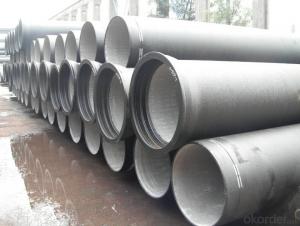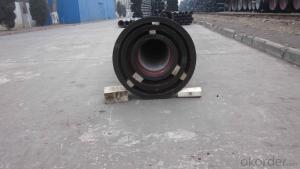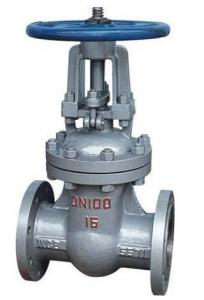DUCTILE IRON PIPE DN600
- Loading Port:
- China Main Port
- Payment Terms:
- TT OR LC
- Min Order Qty:
- -
- Supply Capability:
- -
OKorder Service Pledge
OKorder Financial Service
You Might Also Like
Specification:
1) The standard of pipe: ISO2531:1998, K9
2) Effective length: 6m
3) Inner cement line: Portland cement line as per ISO4179
4) Zinc coating: at least 130g/m2 as per ISO8179
5) Bitumen painting: at least 70um as per ISO8179
6) With 100% quantity of NBR ring, or SBR ring, or EPDM ring as per ISO4633
7) DN80mm-800mm
8) High strength, lighter than grey iron, good corrosion resistance, no furring, small flow resistance, easy fixing, long life tome about 100 yeas
9) Produced by Hangzhou chunfeng machine
10) Checked by automatic inspection equipment
11) Composition:
Chemical composition | |||
Chemical composition | Ductile Cast Iron Pipe (%) | Grey iron pipe (%) | Steel pipe (%) |
C | 3.5-4.0 | 3.2-3.8 | 0.1-0.2 |
Si | 1.9-2.6 | 1.4-2.2 | 0.15-0.4 |
Mn | 0.15-0.45 | 0.4-0.6 | 0.3-0.6 |
P | ≤0.06 | ≤0.3 | 0.02-0.03 |
S | ≤0.02 | ≤0.1 | 0.02-0.03 |
Mg | 0.03-0.06 |
|
|
12) Feature:
Mechanical properties | |||
| Ductile Cast Iron Pipe | Grey Iron Pipe | Steel Pipe |
Tensile Strength(Mpa) | ≥420 | 150-260 | ≥400 |
Yield Strength(Mpa) | ≥300 | No Confirmation | No Confirmation |
Bending Strength(Mpa) | ≥590 | 200-360 | ≥400 |
Elongation (%) | ≥10 | Neglected | ≥18 |
Brinell Hardness(HBS) | ≤230 | ≤230 | About 140 |
13) T type mechanical joint
14) Packing: in bulk or container
- Q:How are ductile iron pipes joined to fittings and valves?
- Ductile iron pipes are typically joined to fittings and valves through a process known as flanged connection or mechanical joint. Flanged connections involve the use of flanges, which are circular discs with evenly spaced holes around the perimeter. These flanges are bolted together, creating a tight seal between the pipe and the fitting or valve. To join a ductile iron pipe to a fitting or valve using a flanged connection, the pipe end is first prepared by cleaning and deburring any rough edges. A gasket made of rubber or other suitable material is then placed between the pipe end and the flange face. The flange is aligned with the pipe, and bolts are inserted through the holes in the flange, passing through corresponding holes in the fitting or valve. Once all the bolts are in place, they are tightened evenly, gradually applying pressure to compress the gasket and create a secure and leak-proof seal. To ensure proper alignment and sealing, tightening the bolts is typically done in a specific pattern or sequence. Alternatively, ductile iron pipes can also be joined to fittings and valves using mechanical joints. This involves the use of a rubber gasket or gland that is inserted into a groove on the pipe end. The fitting or valve also has a corresponding groove, and when the two are brought together, the gasket is compressed, creating a tight seal. Mechanical joints offer some flexibility, allowing for slight movement or expansion and contraction of the pipe. This can be beneficial in applications where there may be thermal variations or ground movement, reducing the risk of pipe failure. Both flanged connections and mechanical joints are widely used in various industries and applications that require the joining of ductile iron pipes to fittings and valves. The choice of joining method depends on factors such as the specific application, pipe size, pressure requirements, and local codes and regulations.
- Q:Ways of connecting ductile iron pipes
- In our country, the national standards stipulated annealing, centrifugal casting, water delivery with ductile iron, straight pipe, pipe fittings, aprons and other technical requirements, China's production of ductile iron pipe products must meet the current national standards.
- Q:Can ductile iron pipes be used for underground fire hydrant systems?
- Yes, ductile iron pipes can be used for underground fire hydrant systems. Ductile iron pipes are known for their strength, durability, and resistance to corrosion, making them a suitable choice for underground installations. They can withstand the high pressure and flow rates required for fire hydrant systems, ensuring reliable water supply for firefighting purposes.
- Q:Are ductile iron pipes suitable for use in chemical storage tanks?
- No, ductile iron pipes are not suitable for use in chemical storage tanks.
- Q:It's not easy to drill ductile iron with cobalt high speed steel bit. Please help to point it out
- The material can be annealed and the process is simple, that is, heating the workpiece and cooling it naturally. In this way, the hardness of the workpiece can be reduced.
- Q:What are the different joint types available for ductile iron pipes?
- There are several different joint types available for ductile iron pipes. These joints play a crucial role in ensuring the integrity and reliability of the pipeline system. 1. Push-on Joint: This is the most common type of joint used for ductile iron pipes. It involves a rubber gasket that is placed inside the bell end of the pipe, and the spigot end is then pushed into the bell, creating a tight seal. This joint is quick and easy to assemble and provides excellent resistance to soil movement and water pressure. 2. Mechanical Joint: This joint involves a gland and follower that are tightened around the spigot end of the pipe using bolts and nuts. The mechanical joint provides a strong and durable connection and is commonly used for larger diameter pipes or in applications where higher pressure or thrust loads are expected. 3. Flanged Joint: Flanged joints are used when the pipes need to be connected to other components, such as valves or fittings. The ends of the pipes are machined and fitted with flanges that are bolted together using gaskets to create a secure connection. Flanged joints are often used in industrial applications or where frequent disassembly is required. 4. Restrained Joint: Restrained joints are designed to withstand higher thrust forces and prevent the pipe from separating or pulling apart. They typically utilize a combination of mechanical joint components, such as bolts and glands, along with additional restraining elements like welded or bolted-on restraints. These joints are commonly used in high-pressure applications or where the pipeline is subjected to significant external forces. It is important to select the appropriate joint type based on factors such as pipeline design, operating conditions, and installation requirements. Consulting with a knowledgeable engineer or pipe manufacturer can help determine the most suitable joint type for a specific ductile iron pipe application.
- Q:Are there any specific standards or specifications for ductile iron pipes?
- Ductile iron pipes have specific standards and specifications that must be adhered to. The American Water Works Association (AWWA) and the International Organization for Standardization (ISO) are responsible for establishing the most commonly used standards for these pipes. AWWA has developed the AWWA C151 standard, which covers everything from design and manufacturing to testing, installation, and maintenance requirements for ductile iron pipes used in water and wastewater applications. This standard outlines the materials, dimensions, and mechanical properties of the pipes, as well as the necessary coatings and linings. Similarly, ISO has created the ISO 2531 standard, which provides guidelines for the design, manufacturing, testing, and installation of ductile iron pipes in water and wastewater systems. This standard addresses various aspects, including dimensions, mechanical properties, coatings, and linings. In addition to these well-known standards, there may be other regional or national standards that are specific to certain countries or regions. These standards typically align with the AWWA and ISO standards or may have additional requirements that are specific to local conditions or regulations. Compliance with these standards ensures that ductile iron pipes meet the required quality and performance standards. It also promotes the interoperability and compatibility of ductile iron pipes across different systems and countries, which in turn enables reliable and efficient water distribution and wastewater management.
- Q:Are ductile iron pipes suitable for power plant cooling systems?
- Yes, ductile iron pipes are suitable for power plant cooling systems. Ductile iron pipes offer excellent strength, durability, and corrosion resistance, making them ideal for handling high temperature and high-pressure water flows commonly found in power plant cooling systems. Additionally, their flexibility and ease of installation make them a cost-effective choice for such applications.
- Q:Are ductile iron pipes suitable for hydroelectric power plants?
- Yes, ductile iron pipes are suitable for hydroelectric power plants. Ductile iron pipes are known for their strength, durability, and flexibility, making them an ideal choice for various applications in the water industry, including hydroelectric power plants. These pipes can withstand high pressure and are resistant to corrosion, making them suitable for transporting water at different stages of the hydroelectric power generation process. Additionally, ductile iron pipes have a long service life and require minimal maintenance, reducing the overall operating costs of the power plant. Hence, ductile iron pipes are a reliable and suitable option for hydroelectric power plants.
- Q:Ductile iron 600-3 grade, tensile strength, how to test, there is a simple way?
- 600-3 is pearlite + a small amount of ferrite matrix ductile iron. Pearlite edge region. 10%, center. 70600-3. Two sets of numbers indicating the grades and mechanical properties of nodular cast iron. The former represents the minimum tensile strength
1. Manufacturer Overview |
|
|---|---|
| Location | |
| Year Established | |
| Annual Output Value | |
| Main Markets | |
| Company Certifications | |
2. Manufacturer Certificates |
|
|---|---|
| a) Certification Name | |
| Range | |
| Reference | |
| Validity Period | |
3. Manufacturer Capability |
|
|---|---|
| a)Trade Capacity | |
| Nearest Port | |
| Export Percentage | |
| No.of Employees in Trade Department | |
| Language Spoken: | |
| b)Factory Information | |
| Factory Size: | |
| No. of Production Lines | |
| Contract Manufacturing | |
| Product Price Range | |
Send your message to us
DUCTILE IRON PIPE DN600
- Loading Port:
- China Main Port
- Payment Terms:
- TT OR LC
- Min Order Qty:
- -
- Supply Capability:
- -
OKorder Service Pledge
OKorder Financial Service
Similar products
New products
Hot products
Hot Searches
Related keywords





























